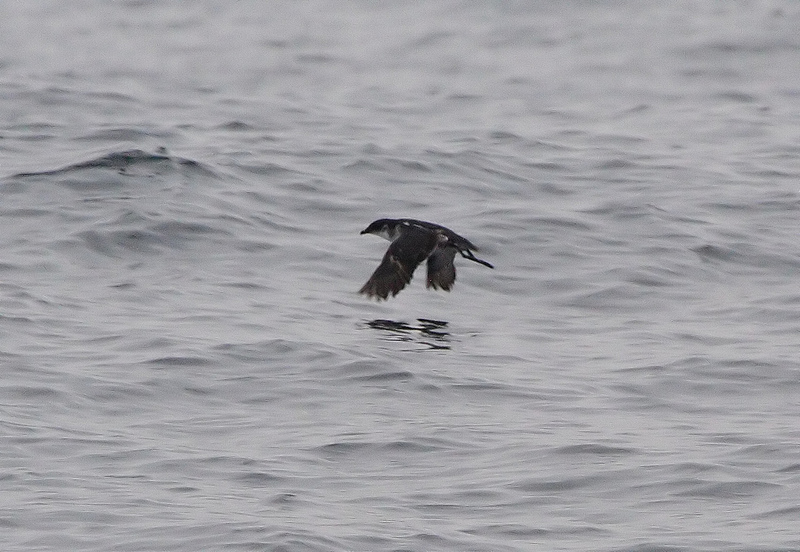Diving Petrel (Family: Pelecanoididae, Genus: Pelecanoides) - Wiki Diving petrel
From Wikipedia, the free encyclopedia
Scientific classification
Kingdom: Animalia
Phylum: Chordata
Class: Aves
Order: Procellariiformes
Family: Pelecanoididae
[Photo] Yunco (Pelecanoides garnotii), Peruvian Diving Petrel in flight. Frente a Quintero. Junio 30, 2007. Source: Flickr (www.flickr.com/photos/pablocaceres/1066400173/). Author: pablo_caceres_c (www.flickr.com/photos/pablocaceres/).
The diving petrels are seabirds in the bird order Procellariiformes. There are four very similar species all in the family Pelecanoididae and genus Pelecanoides Lac??p??de, 1799. They are auk-like small petrels of the southern oceans. The resemblances with that unrelated group are due to convergent evolution, since both families feed by pursuit diving, although some researchers have in the past suggested that the similarities are due to relatedness. Amongst the Procellariiformes the diving petrels are the family most adapted to life in the sea rather than flying over it, and are generally found closer inshore than other families in the order. Of the four species two, the Peruvian Diving Petrel and the Magellan Diving Petrel, have highly restricted ranges around South America's coasts, whilst the Common Diving-Petrel and the South Georgia Diving Petrel range widely across the southern oceans, breeding on islands off New Zealand, sub-Antarctic islands in the Indian Ocean, and islands in the south Atlantic (like Tristan da Cunha).
Diving petrels are plankton feeders, taking mostly crustacean prey such as krill, copepods and the amphipod Themisto gaudichaudii, also taking small fish and squid. They have several adaptations for obtaining their prey incliude short powerful wings, a gular pouch for storing food, and their nostrils open upwards rather than forward pointing as it is in other tubenoses.
These birds nest in colonies on islands. One white egg is laid in a burrow in turf or soft soil. They are nocturnal at the breeding colonies. It has a long period of parental care (around 45 - 60 days) in the burrow, but once the chick fledges out to sea it is on its own.
Diving petrels are amongst the world's most numerous birds, with Common and South Georgia Diving Petrels numbering several million pairs each. The Peruvian Diving Petrel, on the other hand, is threatened by guano extraction, introduced species and climate change, and is listed as an endangered species.
The four species are:
- Peruvian Diving Petrel Pelecanoides garnotii
- Magellan Diving Petrel Pelecanoides magellani
- Georgian Diving Petrel Pelecanoides georgicus
- Common Diving Petrel Pelecanoides urinatrix
The evolution and systematics of these birds is not too well researched. Several populations were described as distinct species and while most of them are only subspecies, some may indeed be distinct. The prehistoric fossil record is currently limited to very fragmentary remains described as Pelecanoides cymatotrypetes found in Early Pliocene deposits of Langebaanweg, South Africa; while this bird apparently was close to the Common Diving-petrel, no members of the genus are known from South African waters today (Olson, 1985).
http://en.wikipedia.org/wiki/Diving_petrel
| The text in this page is based on the copyrighted Wikipedia article shown in above URL. It is used under the GNU Free Documentation License. You may redistribute it, verbatim or modified, providing that you comply with the terms of the GFDL. |
